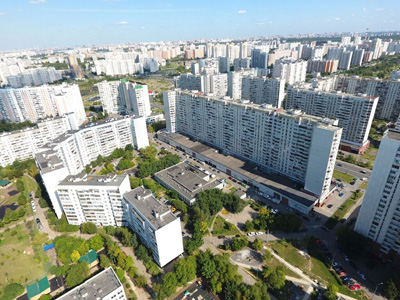The Moscow government is launching a smart district that will become a living lab for piloting smart technologies in the city. The project is implemented in existing urban living area with around 8,000 citizens. It aims to evaluate how technologies adjust residents’ routine and what technologies are mostly used. Moscow authorities aim to adjust the city urban renewal plan based on the results once the pilot is completed.
In April 2018, authorities began implementing technologies in selected buildings situated in Maryino district on the southeast of Moscow. The district includes seven apartment buildings with different years of construction (years from 1996 to 1998). Each residential building has different construction type that gives an advantage to pilot the technologies under various conditions. In total the complex accommodates 2,044 apartments with a square area of 350 m x 300 m.
Interestingly, when creating a smart district nowadays, cities tend to choose new, yet populated, empty or even abandoned areas to build a district from a scratch, which is faster, easier and more cost-efficient. However, Moscow authorities took a courageous decision to create one in an already existing ambience bringing top tech solutions for around 8,000 smart district residents.
Unlike common international practice, Maryino district was chosen to pilot the project for one simple reason: the technologies piloted in real-life environment are more likely to be more realistic and faster adaptable to the lives of modern citizens. Now authorities and developers receive immediate feedback from the citizens and can amend and consider residents’ requests in the real-time which guarantees avoidance of potential unmet expectations, disapproval or misunderstanding in the future.
Now smart district residents can access smart systems responsible for heating, lighting, waste collection and many others. In total selected residential buildings are equipped with twenty nine different smart technologies. Those aim to improve the quality of life, provide comfort and safety and optimize expenditures of residents and city hall as well. Starting from now, Moscow is to evaluate the effectiveness of the implemented technologies.
Andrey Belozerov, Strategy and Innovations Advisor to CIO of Moscow explained: “We didn’t want to build a district from a scratch as a test bed far from real-world settings. Our aim was to test technologies in inhabited neighborhood so it allows us to see whether citizens get advantage of new technologies in their everyday tasks. When the pilot is completed we aim to adjust the city urban renewal plan, so Muscovites enjoy living in similar technology-savvy buildings around the city in the future.”
As part of the project the first charging station for electric vehicles situated in residential district has been installed in Moscow–it has already become the most popular charging station for electric vehicles in the city. In addition, free Wi-Fi network is available on site. Each resident can install free mobile application to answer the house intercom when no one is around or open the door without a key. Interestingly that every cable for outdoor lighting, wires that provide power to Wi-Fi routers, security surveillance cameras and emergency loudspeakers have been removed underground to clear the sky over the district. It increased the security and aesthetic appearance of the district and the reliability of communication.
The project is implemented in close cooperation with business stakeholders. Russian telecom operator Beeline has also launched a test site for developers of IoT solutions on the territory of the district. The trial will use Ericsson equipment on Beeline’s Narrowband (NB) IoT network. The project is to examine the impact of IoT solutions implemented in the district. The trial enables connections of up to 10,000 devices per base station, and Ericsson has installed two stations in the one km trial zone.

